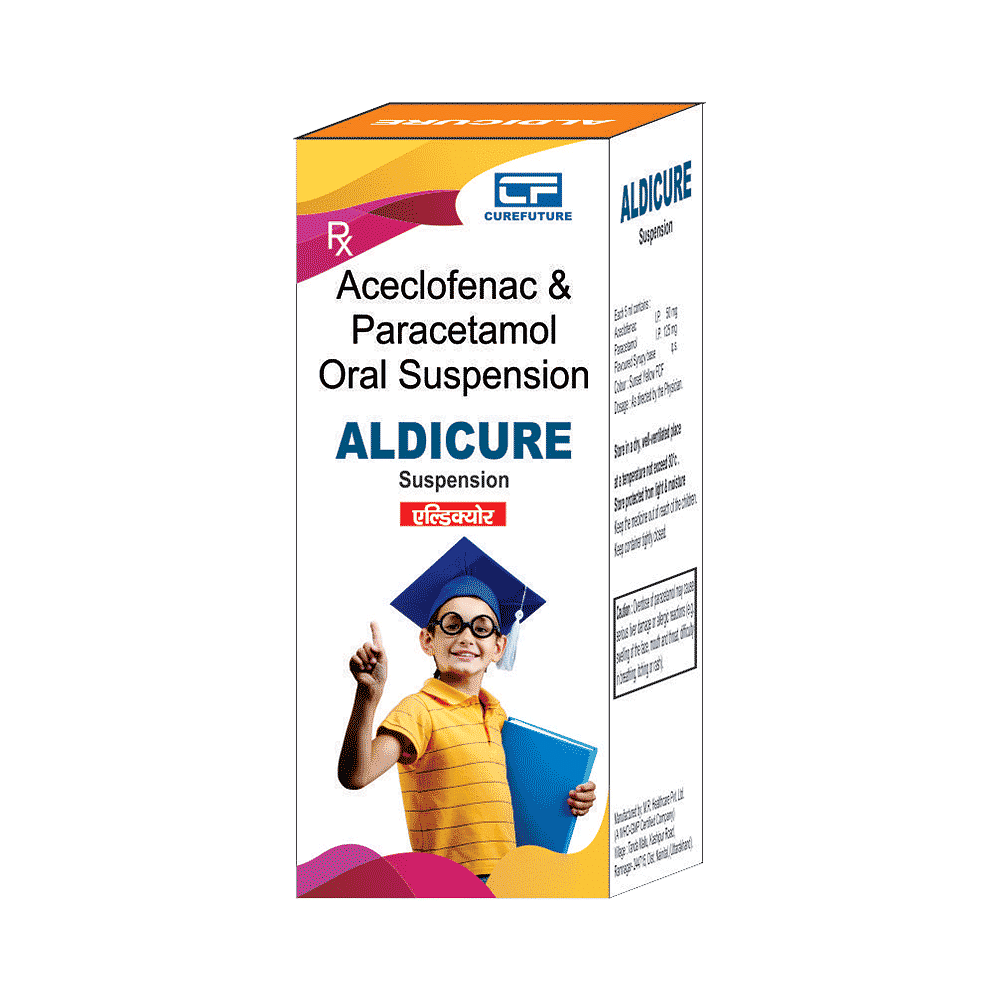
Acenift P Oral Suspension
Manufacturer
Curavax Pharmaceuticals Private Limited
Salt Composition
Aceclofenac (50mg) + Paracetamol (125mg)
Key Information
Short Description
Acenift P Oral Suspension helps lower body temperature (fever) and reduce pain and inflammation (redness and swelling) both in infants and children.
Dosage Form
Oral Suspension
Introduction
Acenift P Oral Suspension is a medication that helps to lower body temperature (fever) and reduce pain and inflammation (redness and swelling) in infants and children. It is available in the form of an oral suspension.
Directions for Use
Give this medicine after food to avoid abdominal discomfort in your child. Maintain a log of your child's temperature. If you do not see any improvement, contact your child's doctor for advice.
How it works
Acenift P Oral Suspension comprises two active ingredients: Aceclofenac and Paracetamol. These medicines work by blocking the action of chemical messengers responsible for pain, fever, and inflammation (redness and swelling).
Quick Tips
Give plenty of fluids to your child to ensure proper body hydration (water-levels) Give your child a balanced diet Encourage your child to have optimum sleep since sick children get tired soon and getting plenty of rest helps them recover faster. Stop the medicine and consult your child's doctor in case your child exhibits allergic rash or stomach pain soon after taking this medicine.
Related Medicines

Rupain AP Oral Suspension

Acwan P Oral Suspension

Kenaz Oral Suspension

Pevinac-P Oral Suspension

Pilofenac-P Oral Suspension

Aldicure Oral Suspension

Clifflam P Oral Suspension

Fibomol-P Oral Suspension

Lifek P Oral Suspension

Aceofen P Oral Suspension
Frequently asked questions
Can I increase or decrease the dose of Acenift P Oral Suspension for my child by myself according to the severity of illness?
No, it is not recommended to alter the dose of the medicine without consulting a doctor. While increasing the dose without proper judgment may lead to toxicity, decreasing it may cause recurrence of symptoms. Therefore, for best results, always consult your child's doctor if you feel a change in dose may be needed.
How much Acenift P Oral Suspension should I give to my child?
Your child's doctor will prescribe the correct dosage based on their age and weight. It is important to follow the prescribed dosing schedule for optimal results and safe recovery.
How should Acenift P Oral Suspension be stored?
Acenift P Oral Suspension should be stored at room temperature in a dry place, away from direct heat and sunlight. It is crucial to keep all medicines out of reach of children to prevent accidental ingestion.
Can all children be given the same dose of Acenift P Oral Suspension?
No. The correct dosage for each child depends on their specific needs. Acenift P Oral Suspension is not suitable for everyone and dosage will vary based on age, weight, and other factors. Always consult a doctor to determine the appropriate dose for your child.
When will my child feel better?
It may take a few days to weeks of treatment with Acenift P Oral Suspension before your child experiences relief from symptoms, but this can vary depending on the severity of their condition. Always follow your doctor's instructions and continue giving the medicine as prescribed to ensure the best outcome.
Are there any serious side effects of this medicine for my child?
While generally well-tolerated, Acenift P Oral Suspension can cause adverse reactions. If you notice your child experiencing symptoms like persistent vomiting, swelling, decreased urine output, or an allergic reaction, seek immediate medical attention.
Are there any specific contraindications associated with the use of Acenift P Oral Suspension?
Acenift P Oral Suspension should not be used in patients with known allergies to any of its components or excipients. It is also crucial to avoid this medicine for those with a history of stomach ulcers, active or recurrent bleeding ulcers, and heart failure. Furthermore, it's best to avoid this medication for individuals with liver or kidney disease.


